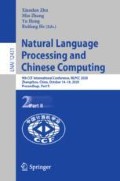Abstract
Due to the ability of expressively representing narrative structures, proposition-aware learning models in text have been drawing more and more attentions in information extraction. Following this trend, recent studies go deeper into learning fine-grained extra-propositional structures, such as negation and speculation. However, most of elaborately-designed experiments reveal that existing extra-proposition models either fail to learn from the context or neglect to address cross-domain adaptation. In this paper, we attempt to systematically address the above challenges via an adversarial BiLSTM-CRF model, to jointly model the potential extra-propositions and their contexts. This is motivated by the superiority of sequential architecture in effectively encoding order information and long-range context dependency. On the basis, we come up with an adversarial neural architecture to learn the invariant and discriminative latent features across domains. Experimental results on the standard BioScope corpus show the superiority of the proposed neural architecture, which significantly outperforms the state-of-the-art on scope resolution in both in-domain and cross-domain scenarios.
Supported by National Natural Science Foundation of China (Grants No. 61703293, No. 61672368, No. 61751206).
Access this chapter
Tax calculation will be finalised at checkout
Purchases are for personal use only
References
Chen, T., Xu, R., He, Y., et al.: Improving sentiment analysis via sentence type classification using BiLSTM-CRF and CNN. ESA 72, 221–230 (2017)
Chen, X., Sun, Y., Athiwaratkun, B., et al.: Adversarial deep averaging networks for cross-lingual sentiment classification. arXiv:1606.01614 (2016)
Fancellu, F., Lopez, A., Webber, B.: Neural networks for negation scope detection. In: ACL, pp. 495–504 (2016)
Ganin, Y., Ustinova, E., Ajakan, H., et al.: Domain-adversarial training of neural networks. J. Mach. Learn. Res. 17(1), 2030–2096 (2015)
Goodfellow, I.J., Pouget-Abadie, J., Mirza, M., et al.: Generative adversarial nets. In: NIPS, pp. 2672–2680 (2014)
Graves, A., Mohamed, A.R., Hinton, G.: Speech recognition with deep recurrent neural networks. In: ICASSP, pp. 6645–6649 (2013)
Huang, Z., Xu, W., Yu, K.: Bidirectional LSTM-CRF models for sequence tagging. arXiv:1508.01991 (2015)
Lafferty, J., Mccallum, A., Pereira, F.: Conditional random fields: probabilistic models for segmenting and labeling sequence data. In: ICML, pp. 282–289 (2001)
Lample, G., Ballesteros, M., Subramanian, S., et al.: Neural architectures for named entity recognition. In: NAACL, pp. 260–270 (2016)
Makhzani, A., Shlens, J., Jaitly, N., et al.: Adversarial autoencoders. arXiv:1511.05644 (2016). Version 2
Morante, R., Daelemans, W.: A metalearning approach to processing the scope of negation. In: CoNLL, pp. 21–29 (2009)
Morante, R., Liekens, A., Daelemans, W.: Learning the scope of negation in biomedical texts. In: EMNLP, pp. 715–724 (2008)
Morante, R., Sporleder, C.: Modality and negation: an introduction to the special issue. Comput. Linguist. 38(2), 223–260 (2012)
Özgür, A., Radev, D.R.: Detecting speculations and their scopes in scientific text. In: EMNLP, pp. 1398–1407 (2009)
Pyysalo, S., Ginter, F., Moen, H., et al.: Distributional semantics resources for biomedical text processing. In: LBM, pp. 39–44 (2013)
Qian, Z., Li, P., Zhu, Q., et al.: Speculation and negation scope detection via convolutional neural networks. In: EMNLP, pp. 815–825 (2016)
Qin, L., Zhang, Z., Zhao, H., et al.: Adversarial connective-exploiting networks for implicit discourse relation classification. In: ACL, pp. 1006–1017 (2017)
dos Santos, C.N., Xiang, B., Zhou, B.: Classifying relations by ranking with convolutional neural networks. In: ACL, pp. 626–634 (2015)
Sato, M., Manabe, H., Noji, H., et al.: Adversarial training for cross-domain universal dependency parsing. In: CoNLL, pp. 71–79 (2017)
Tang, B., Wang, X., Wang, X., et al.: A cascade method for detecting hedges and their scope in natural language text. In: CoNLL, pp. 13–17 (2010)
Velldal, E., Oepen, S.: Syntactic scope resolution in uncertainty analysis. In: COLING, pp. 1379–1387 (2010)
Velldal, E., Øvrelid, L., Read, J., et al.: Speculation and negation: rules, rankers, and the role of syntax. Comput. Linguist. 38(2), 369–410 (2012)
Vincze, V., Szarvas, G., Farkas, R., et al.: The BioScope corpus: biomedical texts annotated for uncertainty, negation and their scopes. BMC Bioinform. 9(Suppl 11), 1–9 (2008)
Zou, B., Zhou, G., Zhu, Q.: Tree kernel-based negation and speculation scope detection with structured syntactic parse features. In: EMNLP, pp. 968–976 (2013)
Author information
Authors and Affiliations
Corresponding author
Editor information
Editors and Affiliations
Rights and permissions
Copyright information
© 2020 Springer Nature Switzerland AG
About this paper
Cite this paper
Huang, R., Ye, J., Zou, B., Hong, Y., Zhou, G. (2020). Adversarial BiLSTM-CRF Architectures for Extra-Propositional Scope Resolution. In: Zhu, X., Zhang, M., Hong, Y., He, R. (eds) Natural Language Processing and Chinese Computing. NLPCC 2020. Lecture Notes in Computer Science(), vol 12431. Springer, Cham. https://doi.org/10.1007/978-3-030-60457-8_13
Download citation
DOI: https://doi.org/10.1007/978-3-030-60457-8_13
Published:
Publisher Name: Springer, Cham
Print ISBN: 978-3-030-60456-1
Online ISBN: 978-3-030-60457-8
eBook Packages: Computer ScienceComputer Science (R0)


